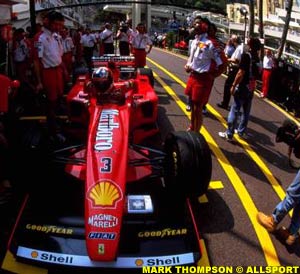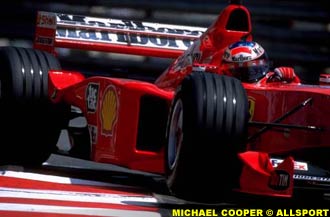Monte Carlo - home of the rich and famous (and many of the drivers on the F1 grid!). It is a spectacular event, and some may say the jewel in Formula One's crown. But is it really the place to race the Formula One cars of today? The power of the current crop of cars is far higher than it was when the roads were first closed for the race in the principality, yet the challenges remain the same. The tight, twisty circuit is very unique and as the only true street circuit on the calendar, it offers some interesting technical challenges to any team.
 Normally, teams will arrive at a Grand Prix with two trucks of cars, spares, tools and equipment, park up behind their pit, and unpack. For the rest of the weekend, they have their workshop in the pit garage, and everything close to hand in the trucks. Not so in Monte Carlo. With the circuit running around everyday roads, there is no space for your Malaysian-style high-tech pit complex. The pit road is so tightly sandwiched between the swimming pool complex and the start line that the back of the swimming pool grandstand looks straight down on the pits - there's hardly room for a spanner, let alone a truck full of tools.
Normally, teams will arrive at a Grand Prix with two trucks of cars, spares, tools and equipment, park up behind their pit, and unpack. For the rest of the weekend, they have their workshop in the pit garage, and everything close to hand in the trucks. Not so in Monte Carlo. With the circuit running around everyday roads, there is no space for your Malaysian-style high-tech pit complex. The pit road is so tightly sandwiched between the swimming pool complex and the start line that the back of the swimming pool grandstand looks straight down on the pits - there's hardly room for a spanner, let alone a truck full of tools.
The pit lane is a tight and difficult place for the teams to work, but it is not only the pit lane that causes concern. In the safety-conscious world of Grand Prix racing there are regular screams of discontent when a gravel trap is too small, or a tyre wall too low, yet at Monaco, the cars fly through the streets, whipping past barriers on both sides without fuss. That is the excitement of the place! It may be near impossible to overtake at a circuit as tight as this, particularly when any move could easily end in the barriers, but the sheer thrill of seeing the drivers truly prove their worth is a sight in itself.
 Coming from average speeds of around 125 mph at the Nurburgring, teams arrive at Monte Carlo expecting something closer to a 95 mph average, and that means quite a different set up is required. Firstly, the cars must be geared to offer more low-end power. The gearbox set up demands a trade off, for instance, if high top speed is required, some low-end power will have to be sacrificed, and vice versa. Because top speeds are low on a circuit as twisty as Monaco, good speed out of the corners is most important, and this is achieved through a high low-end power gear set-up.
Coming from average speeds of around 125 mph at the Nurburgring, teams arrive at Monte Carlo expecting something closer to a 95 mph average, and that means quite a different set up is required. Firstly, the cars must be geared to offer more low-end power. The gearbox set up demands a trade off, for instance, if high top speed is required, some low-end power will have to be sacrificed, and vice versa. Because top speeds are low on a circuit as twisty as Monaco, good speed out of the corners is most important, and this is achieved through a high low-end power gear set-up.
But power is nothing without control, and good mechanical and aerodynamic grip is essential to go fast around the streets. Mechanical traction comes from suspension and tyres, but a street circuit presents challenges to any system. The suspension aims to limit the effect of the bumps and ensure the tyre is in contact with the road for as long as possible during the lap. The road at Monaco, however, is not smooth by any means, and is littered with manhole covers - these are secured before the race weekend (one was ripped up at a race in America some years ago). Teams can test the reaction of their cars to the bumps using a seven-poster rig back at the factory, where the forces from the circuit, logged through telemetry last year, can be put through this year's car on the rig. This allows the team to obtain settings for the suspension before they turn up to the race, and is also used throughout the weekend with data from the actual sessions.
 As for the contact patch, a road circuit doesn't have race rubber laid on it week in week out, so offers less grip than a racetrack. Also, roads have different surfaces for different expected speeds - for instance, an in-town road is designed to offer best grip at 30 mph. Travel seventy on it, and you won't stick to the road as well. Monte Carlo tarmac gives less grip as is not designed to be driven around at the speeds of an F1 car. It also has inconvenient camber on both sides of the road, and large-scale undulations not seen on a normal racetrack (seen particularly as the cars head into Mirabeau).
As for the contact patch, a road circuit doesn't have race rubber laid on it week in week out, so offers less grip than a racetrack. Also, roads have different surfaces for different expected speeds - for instance, an in-town road is designed to offer best grip at 30 mph. Travel seventy on it, and you won't stick to the road as well. Monte Carlo tarmac gives less grip as is not designed to be driven around at the speeds of an F1 car. It also has inconvenient camber on both sides of the road, and large-scale undulations not seen on a normal racetrack (seen particularly as the cars head into Mirabeau).
In an aim to gain more grip, teams look to the air, and cars sprout more wings to increase downforce. This comes at a price of top-speed-reducing drag, but as the circuit is slow, this is not a significant concern. The main modifiable sources of downforce are the front and rear wings, and these will be noticeably different to what we've seen so far this year. Front wing flaps will be angled high, and have larger gurneys (small vertical pieces at the rear of the flap) to increase front-end downforce.
 At the rear, wing sections must take up no more than 70% of a rectangular area viewed directly behind the car. Many teams will have been beavering away to create special wing sections just for high downforce circuits like this, and you can be sure that they will all be using as much of that 70% as possible. In addition, some teams which usually use flick ups at the rear of their sidepod may turn to winglets for extra downforce.
At the rear, wing sections must take up no more than 70% of a rectangular area viewed directly behind the car. Many teams will have been beavering away to create special wing sections just for high downforce circuits like this, and you can be sure that they will all be using as much of that 70% as possible. In addition, some teams which usually use flick ups at the rear of their sidepod may turn to winglets for extra downforce.
As for tactics, pole is goal. Here it is near impossible to pass, even when overtaking backmarkers, so a high grid spot and good pit stop tactics will be more critical than ever. On top of this, teams must consider reliability - both from car and driver. As the cars are not flat out on the throttle as much as at other circuits, engines should not be so stressed, but other parts may suffer instead.
Vibrations due to the bumpy track will be significant, and any parts that are weak to this may be at risk. On the driver side, concentration is critical, and any lapse will end in the barrier (as Ayrton Senna found out in 1988). The challenges are great, but who will prove the winner in casino town? Place your bets.

